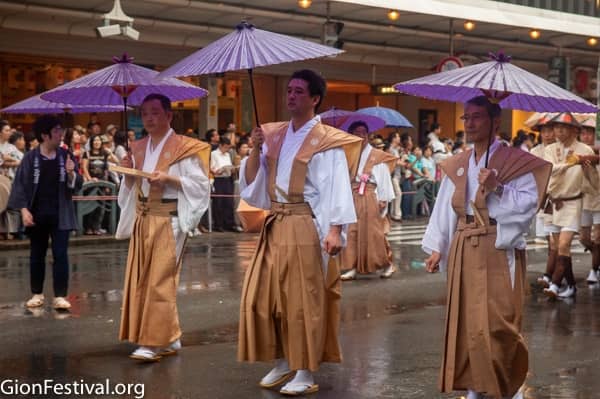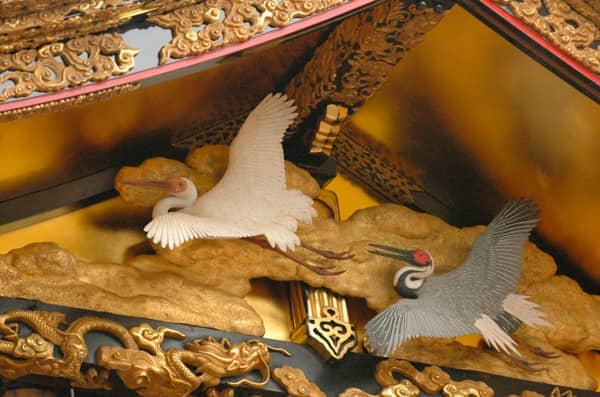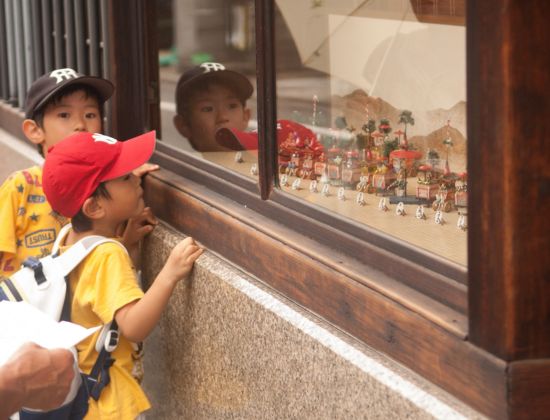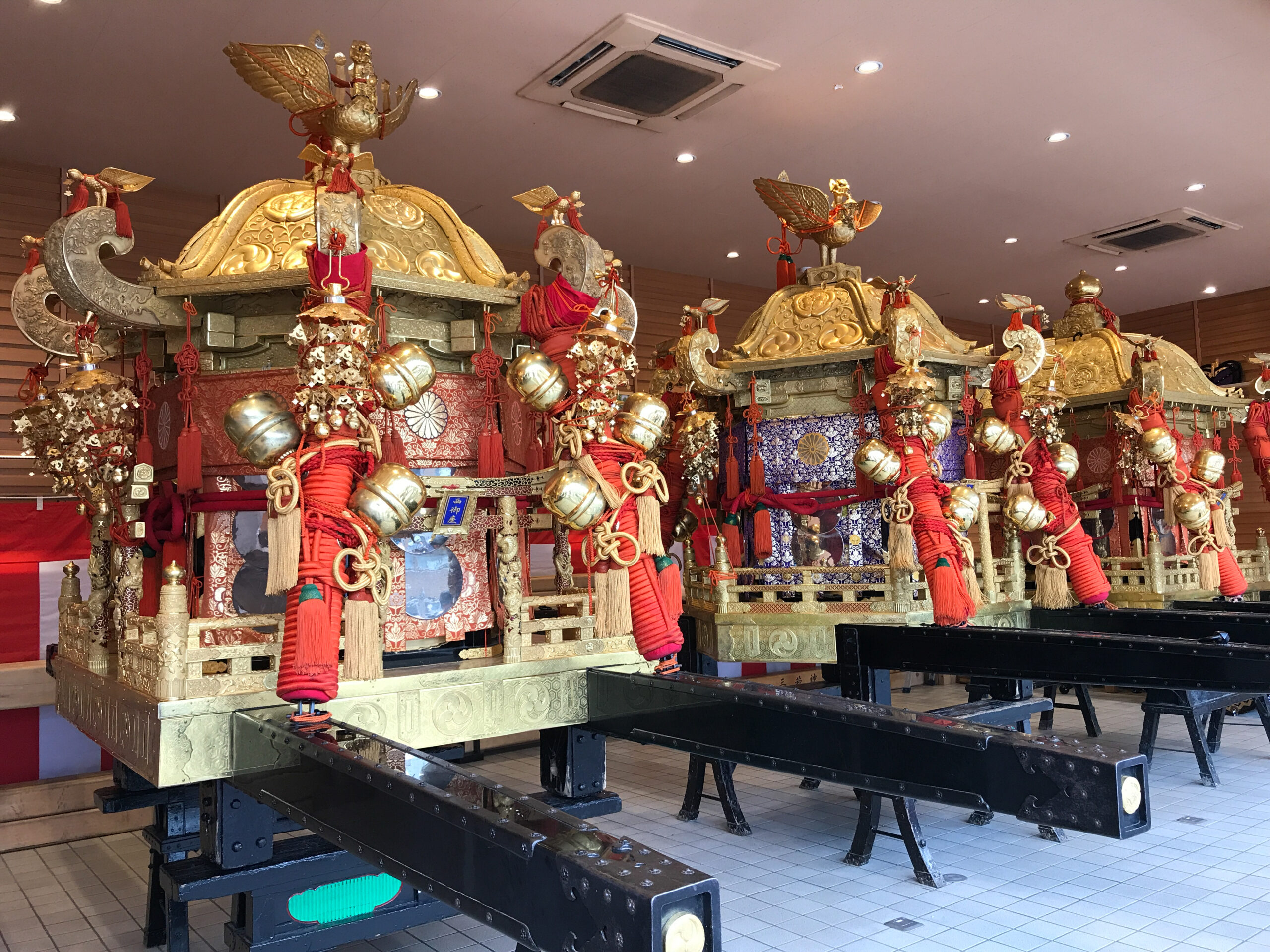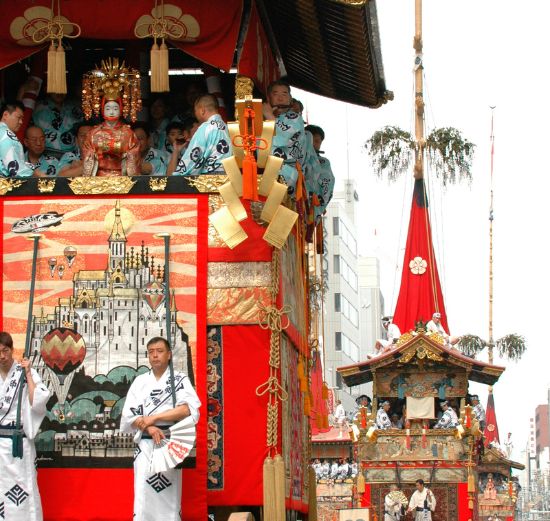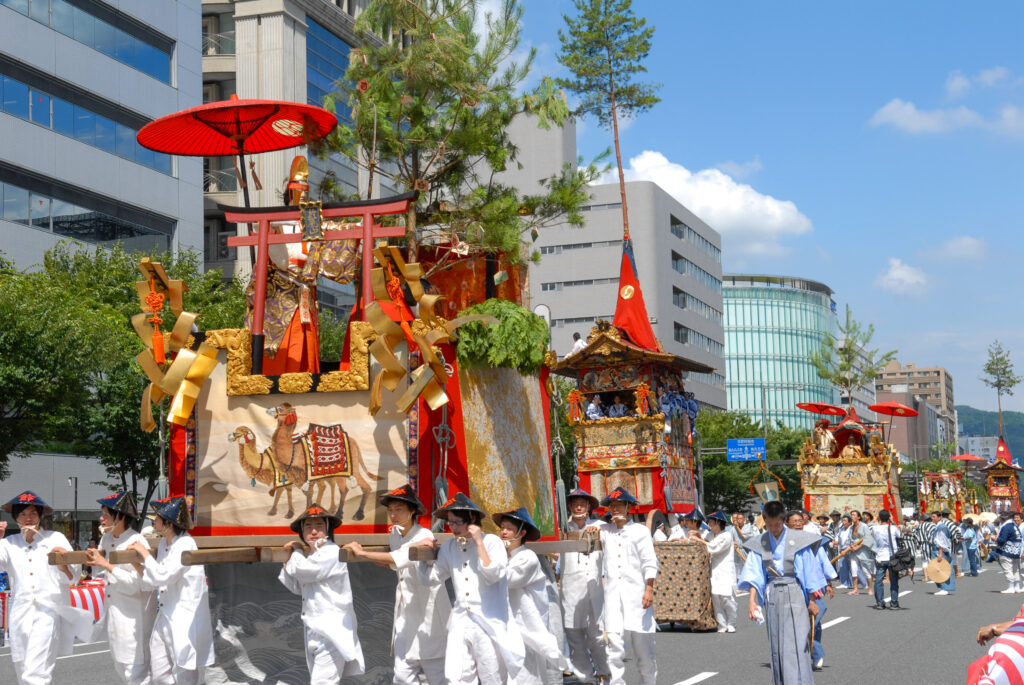
One of numerous Gion Festival iconic events: the spectacular Ato Matsuri floats procession on July 24.
The spectacular Ato Matsuri floats procession, an iconic part of the Gion Festival. Dating to 869 C.E., Kyoto’s Gion Matsuri shines as a beacon of more than a thousand years of Kyoto and Japanese culture. Learn here about the extraordinary historical and cultural gifts it shares over the entire month of July, making it arguably Japan’s most famous festival.
What are the Gion Matsuri’s Origins?
In the 9th century, central Japan suffered from regular outbreaks of terrible plagues, resulting in widespread death and destruction. Torrential downpours, high humidity, and intense heat mark Japan’s rainy season. And in those days, medicine and sanitation were not well developed. The densely populated capital city of Kyoto was especially prone to eruptions of diseases like malaria, cholera, and dysentery.
At that time, people believed that angry spirits (called onryō in Japanese) brought illnesses and other calamities, as revenge. Consequently, the Japanese Emperor Seiwa called for a ritual to appease these spirits. The ritual was named a goryo-e, a meeting of honorable spirits. This name called for the transformation people were hoping would take place. They believed that, through prayers and other forms of placation, spirits could willingly change their demeanor, and help people instead of harming them.
The original ritual involved 66 hoko, long pikes, or halberds. There was one for each of 66 regions that made up the country at that time. We don’t know what happened after the first goryō-e. But when another epidemic struck, the emperor called for another one, and then another, and so on. By a century later, it was an annual event
What Deities Does the Gion Festival Celebrate?
Initially the goryo-e likely addressed the spirits of people who had suffered unjustly from political intrigue during their life. But over the centuries, the spiritual focus of the festival has shifted.
For centuries now, the central deities of the Gion Festival have been Susano-o no Mikoto, Princess Kushi Inada, and their children. These deities’ primary shrine is Yasaka Shrine in Kyoto’s Gion district, giving the festival its name. Susano-o no Mikoto is the god of storms, the original agents of water-borne illnesses and related damage (like floods). Kushi Inada is the goddess of rice, irrigated by the summer storms. Of course, historically rice has had sacred status as the primary source of nourishment for all Japanese.
Where did Today’s Gion Festival Floats Come From?
As mentioned, the original ritual included 66 hoko, upright pikes, or halberds. Gradually the halberds got decorated, and morphed into related shapes, like banners and umbrellas. They also grew in size: by 1000 C.E., many of the hoko needed wheels.
The 16th century saw a significant transformation in the social order and the Gion Festival. Kyoto’s merchant class emerged as a force to be reckoned with. The Gion Festival morphed from a formal aristocratic ceremony to a townspeoples’ ritualistic celebration. Kimono merchants, in particular, began to accumulate serious wealth. The disgruntled upper classes made it illegal for the lower merchant class to dress or build ostentatiously. However, decorating the Gion Festival floats—collectively called yamabokoFloats—presented an opportunity for kimono merchants to flaunt their wealth.
As time passed, the ornamentation grew more and more elaborate. Different Gion Festival float neighborhoods competed against each other to have the most exquisite floats. When the Tokugawa shogunate virtually closed Japan’s borders to outside trade and influence, Gion Festival neighborhoods found ways to procure foreign textiles. Displaying rare, exotic, and essentially black market artworks dazzled the populace. Thanks to centuries of wealthy kimono merchants, local residents and businesses, and thousands of volunteers, we can enjoy the spectacular Gion Matsuri as we know it today.
Major Attractions of Japan’s Most Famous Festival
● The Saki Matsuri Saki Matsuri – The “Early Festival:” July 10-17 or “Early Festival” is from July 10 to 17;
● The Ato Matsuri or “Later Festival” is from July 18 to 24.
The main attractions of the Gion Matsuri take place between July 10 and 24, in two major parts:
The Popular Yoiyama Street Parties and Mikoshi Portable Shrines
The most popular times to visit the Gion Festival are from the evenings until late into the night on July 14-16 and July 21-23. These evenings are called yoiyoiyoiyama, yoiyoiyama, and yoiyama, respectively. Yoi means “eve” or night before, referring to the great Gion Matsuri floats’ processions on the mornings of July 17 and 24. These processions are arguably the most famous single events of the month-long panoply of activities known as the Gion Matsuri. During the Ato Matsuri float procession on July 24, the smaller “Hanagasa Junko” or “Flower Umbrellas Procession” also occurs. It features geisha from the nearby Kyoto geisha districts, professional dancers and musicians, and their students. These professionals also perform on the central stage at Yasaka Shrine from the afternoon.
The Yamaboko Floats
Hoko
Six of the ten hoko are several stories high, with a remarkably tall shingi—an ornamented spire-like pole—at their center. The shingi connects the heavenly world with the earthly one, spirits with humans. A hoko can weigh up to 12 tons and require up to 50 men to pull them through the streets of Kyoto with long, thick ropes.
Yama
The 24 yama are generally smaller than the hoko. Most of them feature a pine tree at their center, instead of a shingi. Some of the yama are so big that they are pulled by dozens of men with long, thick ropes, like the biggest hoko. Other yama are rolled along the streets of Kyoto by men shouldering level wooden supports.
But the distinctions between yama and hoko are not so clear. A few hoko are closer to the original Gion Matsuri hoko, consisting of large umbrellas set into a wheeled float. Two other hoko are in the form of boats, without a shingi. Some yama look like hoko, except they feature a pine tree instead of a shingi. And two yama feature a bridge, without a pine tree.
What’s the Best Yamaboko?
Each person has their own favorites, perhaps determined by a personal connection or experience with that float or community. The first float in the July 17 procession each year, Naginata Boko, and the boat-shaped floats (Fune Boko and Ofune Boko) are remarkable and probably the most widely known. Generally speaking, if you’re interested in the arts, the larger floats have a greater quantity of antique treasures on display. But remember that the display areas are not large, and items are rarely curated in English. Smaller floats have treasures too. They are generally more community-oriented floats and easier to access. They have fewer crowds and may provide visitors with a more unique or intimate experience.
